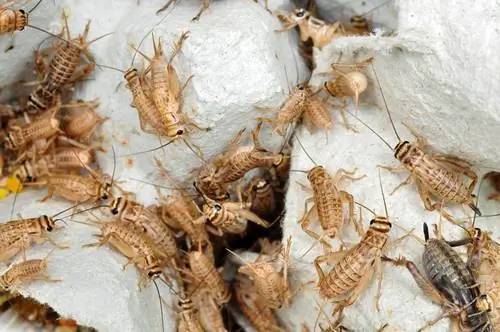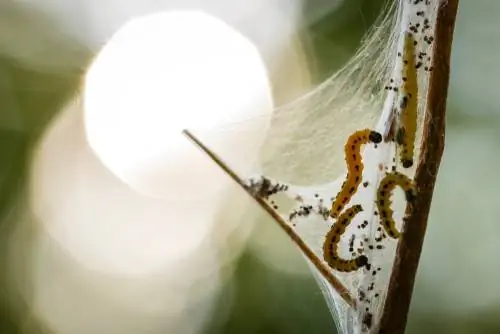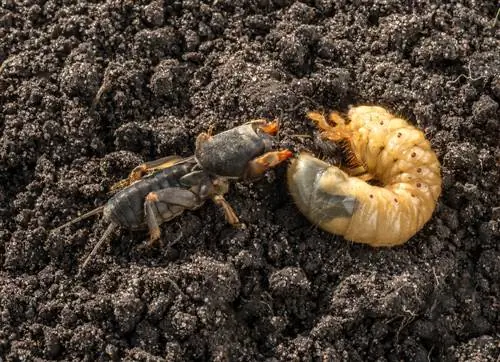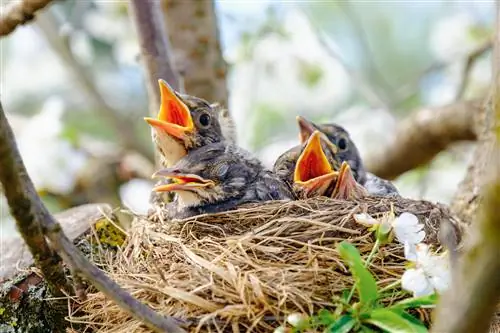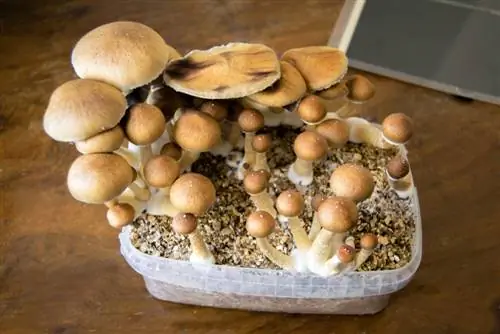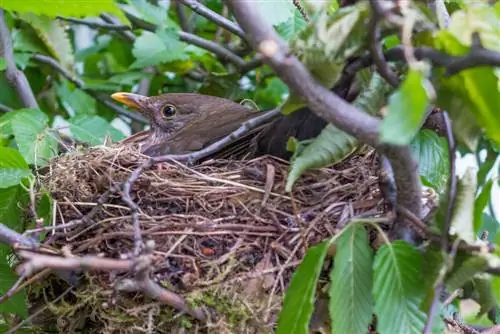- Author admin [email protected].
- Public 2023-12-16 16:46.
- Last modified 2025-01-23 11:19.
Crickets are reminiscent of grasshoppers. They make chirping noises that create a special atmosphere on warm summer nights. Their songs are less romantic as soon as they appear in the apartment. If they find optimal living conditions and spread, only combating them will help.
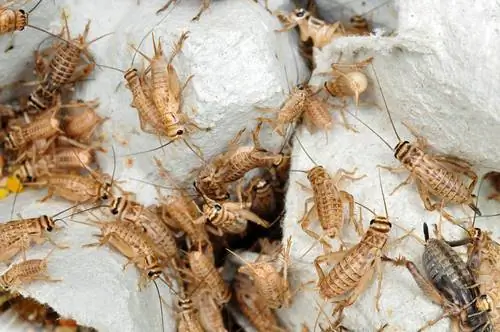
What are crickets?
Behind the cricket is an insect from the cricket family. Its Latin name, Acheta domesticus, indicates its behavior and lifestyle. Acheta is translated as singer, while the species suffix domesticus refers to its frequent occurrence in domestic environments. Therefore crickets are sometimes referred to as house crickets.
In terrariums, insects serve as food for reptiles. Crickets are between 16 and 20 millimeters long. Unlike green-colored locusts, their body has a straw-yellow basic color. The head and pronotum are patterned dark brown to black.
Buy in a specialist store or online
You can buy crickets directly in numerous zoo stores such as Fressnapf. If you decide to buy from a pet store, there are a few things you should keep in mind. Not only the price plays a role, but also the living conditions of the animals, which are often inadequate. Amazon also offers the insects at a reasonable price, although ordering online has more disadvantages than advantages. If in doubt, choose to purchase from other cricket growers in your area.
Questions about purchasing consideration:
- Do crickets appear fit and lively?
- Is the manufacturer stated on the package?
- Do the insects live permanently in the box?
- Are there dead animals in the container?
Tip
When shipping, make sure the delivery time is as short as possible. Just one or two days of lack of food causes stress, causes cannibalism and has a negative impact on the vitality of the insects.
Instructions for breeding yourself
Breeding and keeping insects is comparatively easy, as crickets need enough food and warm temperatures. These conditions can be easily established in a breeding container. Home-grown crickets can later be fed as live food or dried. You save the insects the stress caused by a lack of food, which often occurs when transporting them home from the retailer. Pay attention to species-appropriate conditions to ensure optimal living conditions for the crickets.

Materials and breeding
Use a container measuring 50 x 30 x 30 centimeters. There is space for around 1,000 larvae or 500 adult crickets. Both plastic containers and a lockable terrarium are suitable. To ensure sufficient oxygen supply, you should cover the opening with fly screens. Cover the bottom with sand or wood shavings.
To lay eggs you need a tea strainer, which you fill with substrate. Coconut fibers are suitable for this. Females can use their egg-laying apparatus to pierce through the fine mesh into the substrate to lay their eggs there. At the same time, the eggs are protected in the tea strainer and cannot be eaten.
In order for the larvae to develop undisturbed, additional breeding containers are necessary. After a few days, the tea strainer is removed from the terrarium so that you can place the substrate with the eggs in a breeding container. This is filled with about a centimeter of sand. Egg cartons or crumpled newspaper provide hiding places. If such places of refuge are missing, the larvae themselves reduce their population through cannibalism.
Tip
If you want to remove the adult crickets from the breeding container, you should go outside. Depending on the temperature, the insects vary in their agility and can quickly escape the apartment.
Feeding
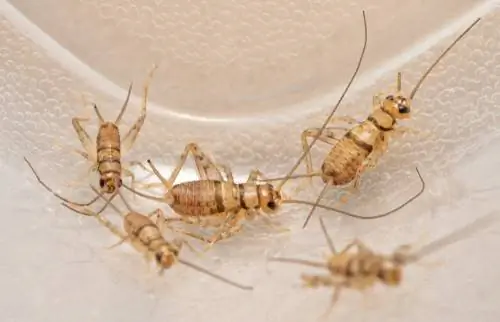
Crickets like it varied
Crickets should always be fed a varied diet. They need a mix of dry and fresh food so that they get all the nutrients they need. Purchased crickets are often exhausted because they are provided with poor quality food. Therefore, you should provide your crickets with energy-rich food shortly after purchasing and before feeding them. Uneaten remains of fresh food should be removed daily to prevent them from becoming moldy. Crickets are very susceptible to disease.
- Dry food: wheat bran, muesli, fish food, oat flakes, rodent pellets
- Fresh food: fruits and vegetables, sprouts and leaves of various meadow herbs
- Vitamin preparations: e.g. cricket breeding concentrate
Put out in the garden
Many breeders eventually have too many crickets in their terrarium that, because of their size, can no longer be fed to smaller reptiles. However, you should not release the surplus animals outside as they can quickly spread en masse there. If you breed animals that accept crickets even when dried or frozen, you should avoid breeding them.
Excursus
Cricket in the apartment
Crickets are more likely to be indoors because here they find suitable living conditions and enough food. There is usually no risk of mass spread within your own four walls. The reason for this is a lack of substrates suitable for laying eggs. However, reproduction can occur in heated greenhouses or in warm and damp rooms where potted plants are located. The chirping annoys everyone in the house, so appropriate measures are necessary to combat it.
Combat with home remedies

If there are individual crickets in the garden or in the apartment, there is no need to panic
Isolated animals can still be easily caught and moved. This measure no longer helps in the event of mass reproduction. A first method to get rid of crickets is to remove the food base. Make sure the crickets can no longer find food. However, this is not so easy, as the animals also spread into the storage cellar and, when resources are scarce, they do not stop at textiles. Various control methods with home remedies are therefore useful.
Fighting with home remedies is gentler on the environment and he alth and is also less expensive.
Hot water
If you have discovered a breeding site, you should vacuum up clutches and larvae that have already hatched. A thorough cleaning ensures that all eggs are eliminated. Wipe out the breeding site with a wet cloth. Larvae and eggs that are deeper in niches and cracks cope well with moisture and water. Therefore, use the hottest water possible when cleaning so that the temperature in the air increases and kills larvae.
Sweet bait
To eliminate the adult crickets, you can make your own bait. To do this, you need an attractant that the insects cannot resist. This lure should be placed in the form of a sticky liquid. If a cricket jumps in, it sticks to the mass. Further movements cause the insect to sink into the liquid and drown.
Step-by-step instructions:
- Mix sugar cane molasses with hot water (ratio 1:4)
- Let the mixture cool down
- fill into shallow bowls
- place in different places in the house
Sticky traps with honey or molasses
With double-sided adhesive bench you can build your own adhesive trap. Place the tape in hiding places such as niches under cabinets and coat the tape with molasses or honey. The sweet scent attracts the insects, which stick to the adhesive tape when they try to eat. The disadvantage of this method is that the animals die slowly due to lack of food.
Barriers with pepper and vinegar
Both spices can be found in almost every household. However, crickets don't like the intensely pungent smell, so you can use pepper and vinegar to scare them away. Brush entrances to supplies and potential entrances in retreat niches with vinegar and sprinkle pepper over them. The barrier lasts about two to three days until the smell subsides. You should then replace the traveling barrier. With continued repetition, the insects will start looking for other food sources and hopefully disappear from your home.
Make natural insecticide
The juice from the roots of the yellow water lily (Nuphar lutea) contains poisonous alkaloids that are fatal to crickets. Squeeze out the rhizomes of the aquatic plant or chop up the leaves. The plant sap is mixed with fresh milk in a ratio of 2:1 and refined with a little honey. The mixture is spread on the surfaces in front of the hiding places. After the crickets lick up the juice, they die.
Combat chemically
You can use bait, sticky traps or insect sprays to get rid of crickets in your home. They work in different ways and are used where the insects retreat during the day. While the trap does not contain any toxic ingredients, gels and sprays use various poisons. Unlike sticky traps, these destroy the crickets within a short time, but bring with them further dangers. In addition, they must be applied several times until all insects have been killed.
| Effect | Disadvantages | ||
|---|---|---|---|
| Contact insecticides | fatal paralysis symptoms | harmful to the environment and he alth | |
| feeding bait | fatal after admission | contains toxic insecticides | |
| Glue traps | Attraction by pheromones | slow death |
Lifestyle
Crickets avoid the light. Therefore, their chirping noises can mainly be heard from dusk onwards. If they have found a shady place, their sounds can also be heard late in the morning. But as a rule, the insects hide in their caves or in warm, moist niches during the day. During the night they are better camouflaged so that they are hardly noticeable to their enemies.
The temperatures also play a role in the activity of the crickets. At warm temperatures around 30 degrees Celsius, the crickets show their optimum activity. The lower the thermometer sinks, the less mobile the insects become. If the temperatures are too hot, they can no longer optimally regenerate their water balance and die.
Male versus female
Male and females differ in their forewings. While the females have a uniform diamond pattern, the males have special structures on the wing surfaces. They use these to produce sounds that are typical of the species. They raise their forewings and spread them outwards. They are then rubbed against each other inwards and outwards, creating the typical chirping sounds. These tones are sometimes referred to as chants because they sound melodic. Chirping serves various purposes.
The sounds of crickets:
- Courtship chirps: three different melodies are intended to impress females
- Mating chirp: short syllable melody directly before mating
- Revier chirping: particularly loud sounds are intended to drive away competitors
Excursus
Stridulation
This technical term refers to a form of noise production that is typical for crickets, grasshoppers and longhorn beetles. They rub certain body parts together to communicate with their peers. Crickets have a particularly rough vein on their right wing, which is equipped with 140 fine teeth. There is a shrill edge on the left wing. When the crickets rub their wings together, the teeth vibrate. They produce a quiet chirping sound, which is amplified by a flexible membrane in the wing and spread throughout the environment.
Crickets vs. crickets
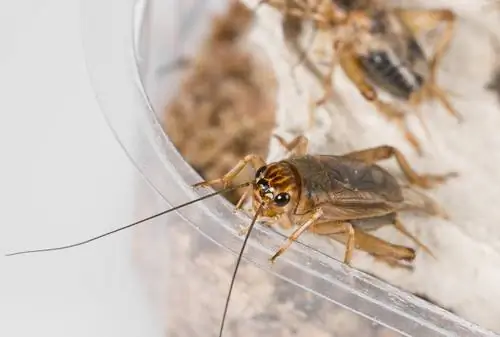
The steppe cricket is also often bred as food for reptiles
Crickets are a family with more than a hundred species. These include species such as crickets, steppe crickets, Mediterranean crickets or short-winged crickets, which are preferably used as food for farmed reptiles. They differ in size and development times. Jumping behavior and vocalizations also show differences.
| Sounds | Jump behavior | Breeding | |
|---|---|---|---|
| Crickets | loud | big jumps | easy |
| Mediterranean cricket | extremely loud | jumps just a little | slightly more difficult |
| Steppe cricket | quiet | hardly jumps | easy |
| Short-winged cricket | moderate | very long jumps | easy |
Hatching of the larvae
Females lay their eggs in the moist soil about two to three days after mating. The clutch can contain between 800 and 2,600 eggs. The number depends largely on the female's diet. If it mainly eats animal food, more eggs are produced than if it eats a plant-based diet.
The eggs are able to absorb moisture. This causes them to swell so that they double their weight. Certain temperatures are necessary for larvae to hatch. If the temperature is 16 degrees Celsius, development into larvae takes around 54 days. If the thermometer consistently shows 35 degrees Celsius, the larvae will hatch after about eight days.
Ideal substrates for egg laying:
- Vegetable leftovers
- Sawdust
- potted plant soil
Development
The larvae, which are initially brightly colored, have no wings and can therefore only crawl. They go through between nine and 16 larval stages before they molt into adult crickets. This development lasts between 80 and 130 days and depends on temperature and food availability. If they are provided with enough plant-based food, they will complete their development within ten weeks.
What do crickets eat?
Crickets are omnivores that feed on both plant remains and animal tissue. Animal food is preferred because it provides more energy and the crickets can therefore reproduce better. They are considered good recyclers of kitchen waste, food scraps and carrion.
The crickets cover their water needs through their food, which is why they like to eat food containing water. Since they don't shy away from food in the household, crickets are considered hygiene pests. If food is poor or scarce, cannibalism can occur.
Natural enemies
The predators include all animals that feed on larger insects. Crickets have no toxic ingredients. They are rich in proteins and can hardly defend themselves against larger predators. Their only protection is the darkness of the night. If danger threatens, the insects retreat into niches and caves.
These animals eat crickets:
- Ants, spiders and wasps
- Birds and bats
- Frogs and Lizards
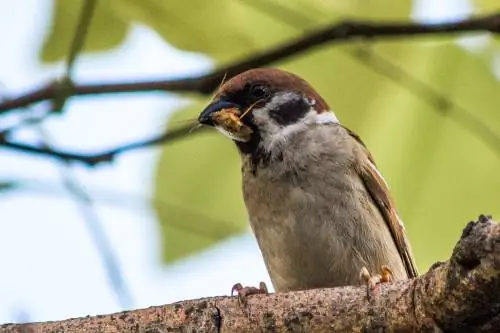
Crickets are delicious food for birds
Natural habitat
The species originally comes from the dry areas of Africa. In East Africa crickets can be found at altitudes of up to 2,600 meters. Today they can be found worldwide and also occur in cooler regions. The first descriptions of the species in Germany date back to the 16th century.
In Europe, however, they are tied to human settlements. Crickets thrive in habitats with high humidity. If the temperatures are consistently high, the insects find optimal living conditions. Both factors are present in compost, which develops high temperatures through fermentation processes and has constant moisture.
These are typical retreats:
- Greenhouses
- Basement
- damp subway shafts
Winter
Outside human settlements, crickets would not survive the winter in Central Europe and other cooler regions outside of Africa. They have not developed mechanisms to survive freezing temperatures because hibernation is not necessary in their natural habitat. As soon as winter sets in, animals die in nature. If you have found a warm and moist place to retreat, you can survive the frosty season.
Frequently asked questions
How old do crickets get?
The life expectancy of insects depends on temperature and food availability. Although their development occurs more quickly at temperatures of around 35 degrees Celsius, they do not survive the heat for particularly long. At an optimal temperature between 28 and 30 degrees Celsius, the insects have a lifespan of twelve weeks.
What do crickets like to eat most?
The crickets prefer animal food, although as omnivores they also eat plant food. In order to breed insects successfully, the food supply plays a major role. Crickets prefer lettuce, carrots or oatmeal.
How do crickets reproduce?
If a male has lured a potential partner into his own arena with his luring melodies, he will go to great lengths again. Females feel the males with their feelers and listen to the melodies with their ears, which are on their legs. If she likes the concert, she mounts the male. These transfer a sac filled with sperm to the female.
When do crickets fly?
Although crickets have fully developed and functional wings, they rarely use them. Their flights can only be observed in exceptional cases when temperatures are very high.
When do crickets chirp?
The mating spectacle of crickets extends from the end of April to the end of June. The males then sit in a place near the burrows they have dug themselves. These caves are up to 20 centimeters long. The males, who once hatched from the eggs in the protection of the caves, use the tunnels as a place of refuge in case of danger. Their monotonous alluring melodies sound from dusk until late at night.

